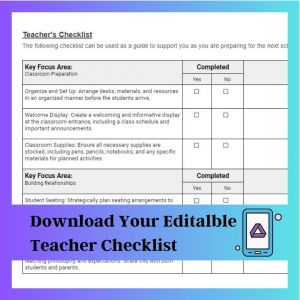As we gear up for the upcoming school year, yes I know it is early, but with testing and IEP season upon us it is never too early to get our ducks in a row.
Getting our ducks in a row is hard so is having an effective communication system that is going to meet the needs of all our students’ parents. You might think that it will be fine, everyone will go with the flow and adhere to what works best for you as the classroom teacher.
Well that is not always the case, preparing for effective communication to support each and every student’s families involves strategic planning, clear communication to ensure a positive and successful academic experience for both students, educators and families.
In this blog post, I will delve into the essential steps to streamline an effective transition to a new school year and develop a communication plan with each of your student’s parents that fosters a collaborative and supportive environment. This checklist for both educators and parents may also be helpful to you.
“Preparing for effective communication to support each and every student’s families involves strategic planning, clear communication to ensure a positive and successful academic experience for both students, educators and families.”
Why should we understand the importance of communication?
Each and every parent wants communication with teachers that is authentic. They do not want to feel that we as educators are checking the boxes. We as educators need to establish a connection that is meaningful and purposeful.
To kick off the transition process, it’s crucial to establish a strong connection with the incoming parents and families in your classroom. Building rapport from the beginning creates a foundation for open and effective communication throughout the school year. This initial step sets the tone for a positive partnership with parents, fostering a conducive learning environment.
As educators, we have to make sure we are clarifying expectations and provide detailed information about the curriculum we will be teaching their child, how we grade their work to show mastery, and any unique classroom dynamics that can help align everyone’s expectations. This proactive approach ensures that both teachers and students are on the same page, reducing potential misunderstandings.
With a new school year comes a new school environment?
With each new school year, students often find themselves in a different educational space and setting. This change encompasses not only a shift in classes and teachers, but also an adjustment to the overall school environment. As the academic calendar progresses, adapting to this new setting becomes crucial for a successful and enriching educational experience.

Parents sometimes reflect on other ways teachers have communicated with them about their child’s progress and behavior, and relish the good old days when everything was the same. This is especially true when a student has had the same teacher throughout their elementary and intermediate years. This is why it is important to establish a clear way of communicating with your students’ parents.
One of the most tangible changes in the new school year is the transition to different classrooms for students, this is especially true for the intermediate and middle school. Navigating the layout of the building and spaces can initially be challenging for students, but it’s an integral part of adapting to the new environment. Familiarizing students with the locations of classrooms, restrooms, and other essential areas ensures a smoother daily routine.
What I love to do is to have an open house outside of the school’s official open house where parents can come with their child and explore the building and ask me any questions and concerns they may have. This allows a more relaxing environment for the parents and students.
The transition to a new school year often brings together a diverse group of students with many gifts, talents, and potentially leading to new friendships and connections. The connection to new classmates not only enhances the overall school experience but also contributes to a supportive and inclusive community. Engaging in icebreaker activities or joining clubs can facilitate these connections.
Are you ready to craft effective communication strategies?
In today’s digital age, leveraging online communication tools is imperative. Creating a dedicated email group or utilizing a communication platform can facilitate efficient information exchange between teachers, students, and parents. This digital approach ensures timely updates and promotes a collaborative learning environment.
If parents and other teachers have a hard time with digital communication, scheduling a time to regularly check in with parents is crucial. Establishing a routine for check-ins with new and ongoing parents is essential for ongoing communication. Regular meetings, either in person or through virtual platforms, provide opportunities to address any concerns, share progress, and maintain an open line of communication. Consistent check-ins contribute to a positive and supportive relationship between all stakeholders.
“Open communication about challenges allows for collaborative problem-solving, strengthening the bond between teachers, students, and parents.”
Throughout the school year, we all experience potential challenges, but it is all about how we embark on these challenges.
Despite careful preparation, challenges may arise during the transition period. I recommend addressing any issues promptly and proactively, fostering a solution-oriented approach. Open communication about challenges allows for collaborative problem-solving, strengthening the bond between teachers, students, and parents.
Feedback from other educators on your team and parents of students in your classroom is a valuable tool for continuous improvement. Encourage an environment where all parties feel comfortable providing feedback, and be open to constructive criticism. This reciprocal communication ensures that everyone is invested in creating a positive and effective learning experience that will meet the needs of each and every learner in your classroom.
The arrival of a new school year brings about more than just a change in classes; it marks a shift in the entire school environment. Adapting to new classrooms, connecting with parents and classmates, understanding school policies, emphasizing communication, and exploring extracurricular activities are integral aspects of this transition. Embracing these changes with a proactive and positive attitude sets the stage for a rewarding academic year filled with growth and new experiences.
Getting ready to transition to the next school year involves meticulous planning and effective communication (a checklist for educators & parents) with new families and students.. Establishing a connection, understanding school policies, and crafting robust communication strategies are essential steps for a successful transition and partnership. By addressing potential challenges head-on and seeking feedback, educators can pave the way for a collaborative and supportive learning environment that meets the needs of each and every learner in their classrooms.
Resources
Please login or register to claim PGPs.
Alternatively, you may use the PGP Request Form if you prefer to not register an account.



